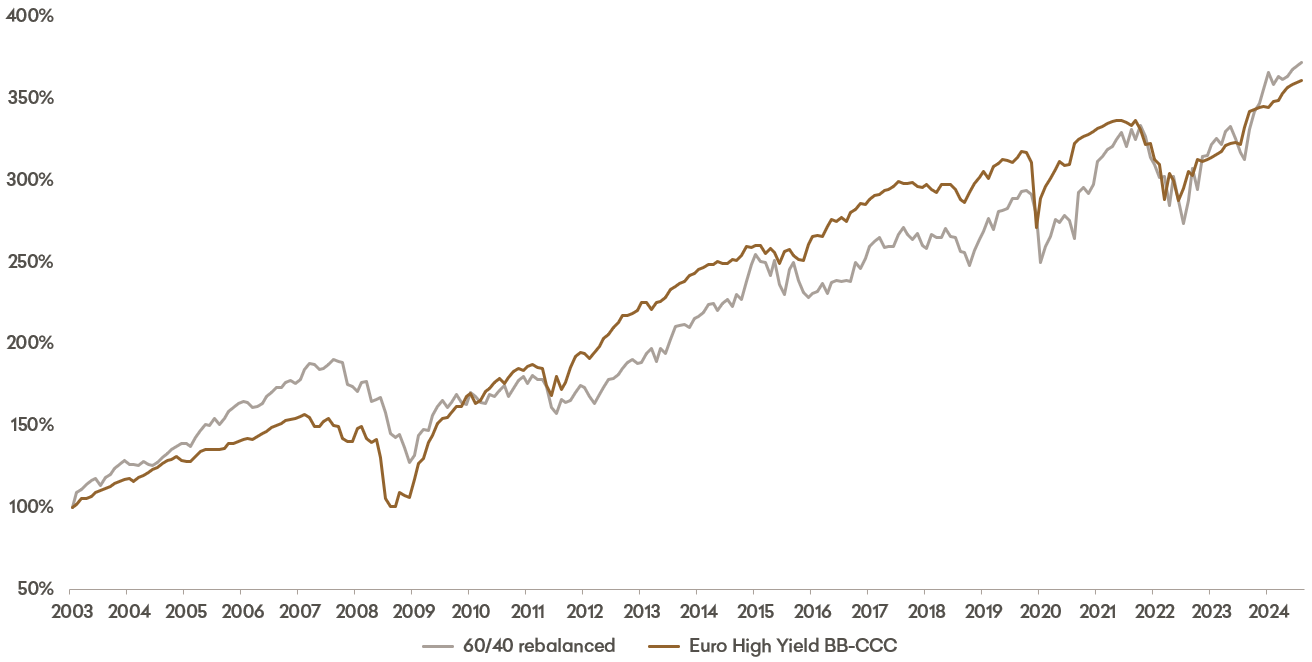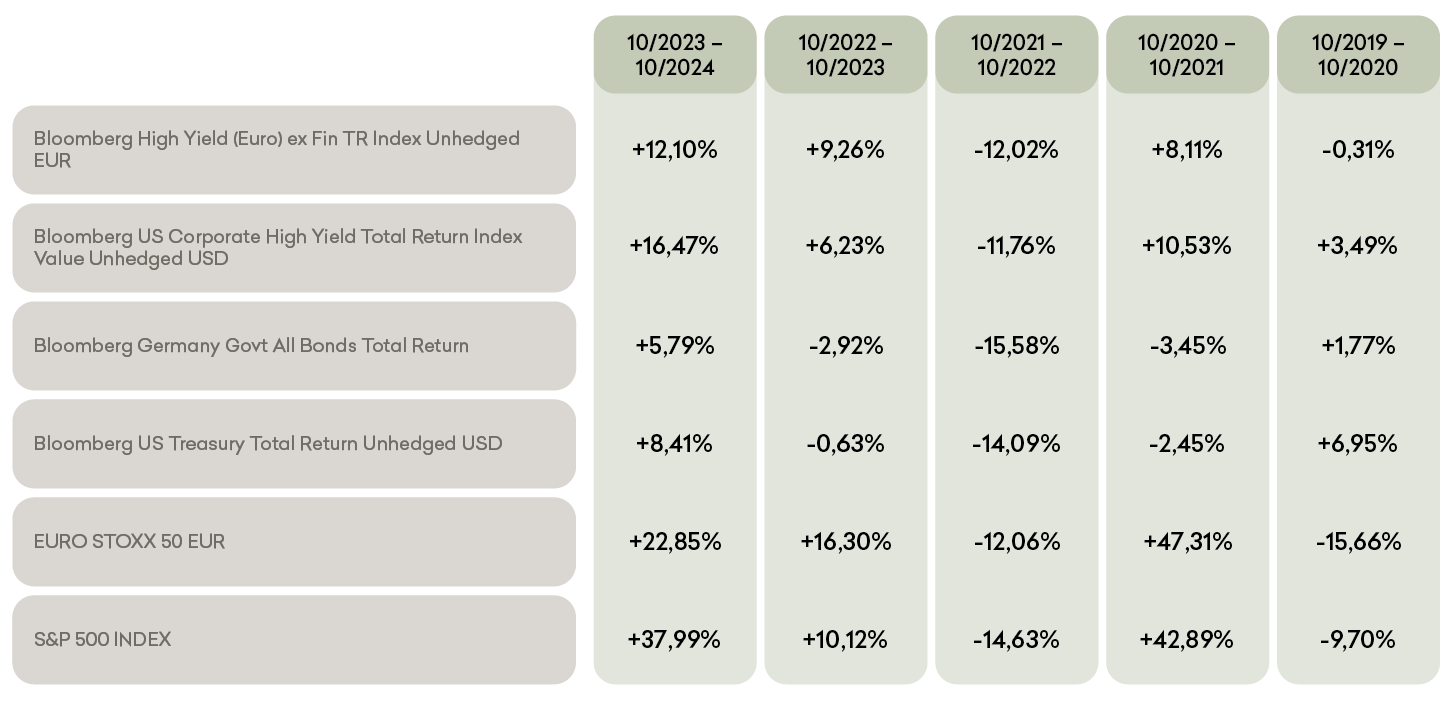
Thomas Rentsch
Senior Portfolio Manager High Yield
Can high yield corporate bonds keep up with a traditional 60/40 portfolio? Our analysis shows: since 2003, European high yield bonds have achieved a similar performance to a traditional 60/40 allocation and with less volatility. A differentiated look at the facts and implications for institutional investors.
The 60/40 portfolio – a strategic allocation of 60% in equities and 40% in government bonds – is traditionally regarded as a benchmark for diversified institutional portfolios. However, empirical evidence from the last two decades shows that high yield corporate bonds can be a more efficient alternative.
The attractiveness of high yield corporate bonds is based on their hybrid characteristics. On the one hand, their duration exposure gives them an interest rate sensitivity similar to that of government bonds. On the other hand, they participate in the company’s success through the credit spread – comparable to equities, but with reduced volatility.
The significant yield pick-up also offers an attractive carry element. The empirical performance analysis for the European market is particularly interesting. As high yield has only been a relevant market here for around 25 years, and in order not to give high yield bonds an unfair advantage, we start the comparison from the low of the equity market in March 2003. Since this point in time, high-yield European corporate bonds were only narrowly beaten by a monthly rebalanced equity/government bonds 60/40 portfolio. However, corporate bonds were more than 10% less volatile during this period (9.1% for HY vs. 10.2% for 60/40).

Source: Bloomberg, own calculations, equities = EuroStoxx50 (SX5E Index), German government bonds = Bloomberg Germany Govt All Bonds Total Return Index (BCEG1T Index), Euro High Yield BB-CCC = Bloomberg Euro High Yield ex Financials Total Return Index (I20672EU Index), 60/40 rebalanced = each month starts with 60% equities & 40% government bonds, 31.03.2003 to 31.10.2024
However, regional differentiation is important. If you look at the US high-yield market, for example, which has been around for almost 40 years, US high yield bonds were able to keep up with a 60/40 portfolio for a long time, but were ultimately clearly left behind due to an impressive equity rally over the last 10 years.

Source: Bloomberg, own calculations, equities = S&P500 (SPX Index), US government bonds = Bloomberg US Treasury Index (LUATTRUU Index), US High Yield BB/B/CCC = Bloomberg US Corporate High Yield Total Return Index (LF98TRUU Index), 60/40 rebalanced = each month starts with 60% equities & 40% government bonds, 31.03.2023 to 31.10.2024.
Conclusion
For institutional investors such as life insurers and pension funds, this means that high yield corporate bonds can – with adequate risk management – represent a sensible strategic alternative or supplement to the classic 60/40 portfolio. Fundamental bottom-up credit analysis, active risk management and an in-depth understanding of technical market factors are crucial for investment success.
With its dedicated credit research team and many years of expertise in fundamental analysis, HAGIM has the necessary resources to leverage this potential for its institutional clients. We develop customized investment solutions that take the specific ALM requirements into account.

Source: Bloomberg (Bloomberg High Yield (Euro) ex Fin TR Index Unhedged EUR (I20672EU Index); Bloomberg US Corporate High Yield Total Return Index Value Unhedged USD (LF98TRUU Index); Bloomberg Germany Govt All Bonds Total Return (BCEG1T Index); Bloomberg US Treasury Total Return Unhedged USD (LUATTRUU Index); EURO STOXX 50 EUR (SX5E Index); S&P 500 INDEX (SPX Index))
Disclaimer
(Wertpapierhandelsgesetz) is provided for information purposes only and should not be construed
as personal investment advice or a recommendation or solicitation to buy, sell or hold
any financial instrument or to adopt any investment strategy. The opinions and statements
contained in this document reflect the current assessment on the date of publication. This information does not constitute a complete analysis of all material facts relating to any country,
region or market. This is not to be considered as financial analysis.
If statements are made about market developments, returns, price gains or other asset
growth as well as risk ratios, these merely constitute forecasts for whose occurrence we assume
no liability. Past performance, simulations or forecasts in particular are not a reliable
indicator of future performance. Assets can go up as well as down. All information has been
carefully compiled; partly with recourse to information from third parties.
Individual details may prove to be no longer or no longer fully accurate, in particular as a
result of the passage of time, changes in the law, current developments on the markets, possibly
at short notice, and may change at any time without prior notice. Therefore, no guarantee
is given that all the information is correct, complete and up to date.
Please inform yourself independently about all costs relevant to you. Maintaining a custody
account may incur costs; ongoing bank charges may also be incurred. Transaction costs depend
on the asset class: For government bonds and collateralised bonds such as mortgage
bonds, they average around 0.02 percent, for corporate bonds 0.085 percent. For less liquid
bonds, the transaction costs can also be significantly higher than 0.25 per cent. It should also
be noted that transaction costs can temporarily be significantly higher during periods of market
stress. For all products sold by HAGIM, all relevant cost information is made available
prior to purchase.
The information is based on our assessment of the current legal and tax situation. If tax or
legal matters are affected, these should be discussed by the addressee with their tax advisor
or lawyer. Investments in financial instruments are associated with both opportunities and
risks. The handling of conflicts of interest at HAGIM is published online in the legal notice on
https://www.ha-gim.com/rechtliche-hinweise. The information contained in this document is
intended for professional clients and eligible counterparties only. This information document
is not directed at US citizens or permanent residents, nor to legal entities domiciled in the
USA, nor may it be distributed in the US.
